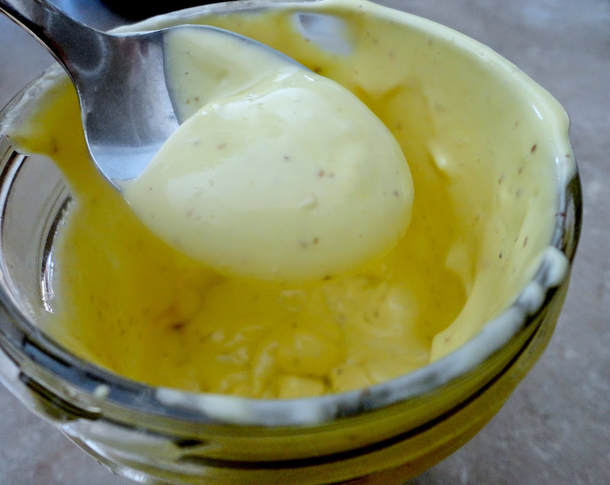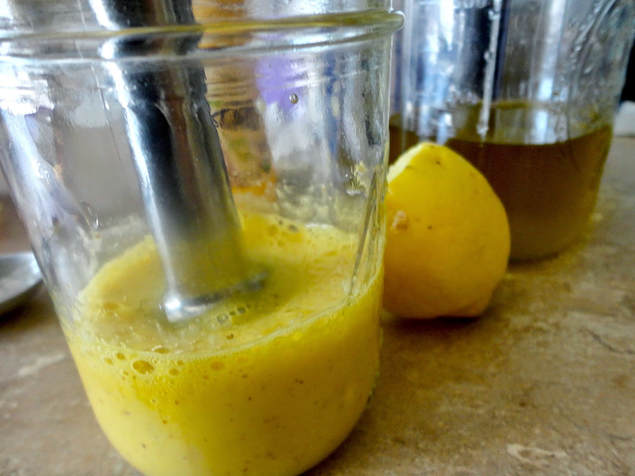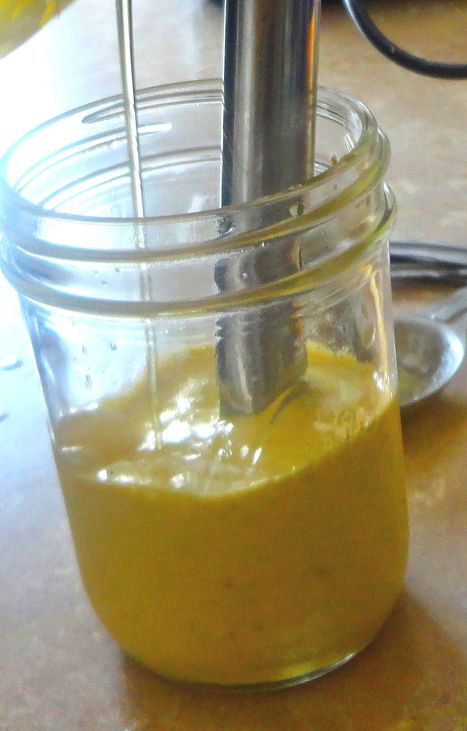|
Now that warmer weather is here, I am all about quick meals that don't take a lot of cook time. One of my favorite quick proteins for this season is the "anything + mayonnaise = salad" meal. Chicken salad using leftover rotisserie chicken, egg salad, or tuna salad can make a lunch or dinner come together pretty quickly, as long as you have the main ingredient: good quality mayo. Homemade mayonnaise is so far superior to store bought mayonnaise, no contest. When it comes to things you should *always* make at home, mayo is on the top of the list. It is easy to make and you can ensure the quality of ingredients when you do it yourself, as most at the store are made with processed oils. This includes organic and "natural" brands, as even most organic mayos are made with highly refined oils. Canola oil, safflower, and refined sunflower oil are the most commonly-used oils in commercial mayonnaise because they are cheap and shelf-stable. Most companies, even the natural ones, are not trying to make the healthiest product, but the one that makes them the most money, so homemade is they way to go when oils are involved. Refined seed oils are high in omega 6 fatty acids, and promote inflammation. When you make your own, you can choose anti-inflammatory oils like avocado, olive, and coconut. It is really disappointing to see brands labeled "olive oil mayonnaise," but still contain large amounts of canola or other oils, but are using olive oil for marketing purposes. Don't be fooled and always read labels, folks! Of course, there are companies like Primal Kitchen, Chosen Foods and Sir Kensington's that are making avocado oil mayonnaise, which is a big step up from the canola-based versions. Though made with pasteurized eggs (which some may need or prefer) and not all organic, these are great options for when you just don't have the time to make your own, which I'm sure will happen from time to time. If you can't find these brands near you or just like to DIY, then try this recipe...you won't regret it. Besides more healthful oils, I like homemade mayo because I can incorporate raw eggs yolks. The raw egg yolks are the emulsifier, helping to combine the oil with the lemon juice and vinegar and create a creamy, smooth texture. Raw egg yolks are rich in vitamins A and E, as well as choline, and eating them raw gives you their full nutrition potential. If you are pregnant, elderly or have a poor immune system, you may do better with cooked yolks instead, however. In addition to egg yolks, this also contains fresh lemon juice and two kinds of unrefined oils: olive oil and avocado oil. The avocado oil has a mild flavor, so it keeps the mayo tasting less strongly of olive oil. You could make it with all one oil if you have a preference, but I like the combination a lot. Olive oil is best when not heated, to protect its nutritional integrity, so this mayo is a great way to get it in your diet. Plus, I love the flavor of good quality olive oil to make the mayo really stand out. Besides chicken and other mayo-based salads, this is also great on a BLT or your favorite sandwich, as a dipper for sweet potato fries, on roasted veggies, or used to make creamy homemade dressing. This recipe uses an immersion, or "hand" blender, as that is what I prefer to use at home. However, you can use a regular blender or food processor with and "s" blade if that's what you have. Just drizzle the oil slowly into the hole in the lid of the blender or food processor instead of directly into the jar.
Homemade Mayonnaise with Olive and Avocado Oils Makes 1 Pint 2 pastured egg yolks, room temperature 1 clove garlic, chopped 2 Tbs lemon juice 2 Tbs apple cider or white wine vinegar 2 tsp dijon or stoneground mustard 1 Tbs raw honey 3/4 tsp sea salt 3/4 cup extra virgin olive oil 3/4 cup avocado oil Optional add ins: your favorite herbs or seasonings like rosemary, thyme, green chiles, or scallions In a wide-mouth glass jar, add the egg yolks. Using a fork or whisk, lightly whip the egg yolks until they are foamy. Add the garlic, lemon, vinegar, honey, mustard, and salt. They honey really helps to cut the oiliness of the mayo and bring out a really nice flavor, but could be omitted if need be. Blend these ingredients together until well incorporated. Now comes the emulsion step, which is the most crucial. When pouring your oils into the liquid mixture, you must pour slowly and steadily, to allow the ingredients to combine and emulsify properly. When emulsified, the mayo will come out thick and creamy, with a very light color. If not properly emulsified, also known as "broken" in the culinary world, the mixture will appear chunky and almost curdled. This can be fixed, so don't panic if you are new to this, just use extra care to go slowly. Pour in the oils, one at a time, into the egg mixture, and keep the immersion blender running and in the jar as you pour. The mixture will start to thicken and get creamy. You want to pour with a very thin stream of the oil to make sure the correct consistency is reached. It is much easier, especially if you are a novice at this, to use a liquid measuring cup with a pour spout. This will help you maintain a nice, thin stream as you are pouring, as the slow pour with a thin stream really helps it emulsify well. Once it is creamy and lightly colored, it is good to go. You can season to taste at this point. Put a lid on your jar and refrigerate. This should keep for at least a week or two in the fridge, if it lasts that long from the hungry masses. Trouble shooting: If your mayo "breaks" and starts to look curdled, it can be remedied. Don't freak out. Add 1 more egg yolk to the mixture, along with 2 Tbs water. Blend that in and, just like when you were adding the oil the first time, keep blending that and add olive oil, 1 tsp at a time, into the broken mayo until it becomes emulsified and becomes light and creamy. Optional recipe twist: For a different flavor and fatty acid profile, you could swap one of these oils out for coconut oil. It will need to be liquid when you use it, so warm it to 75 degrees to get it ready to make mayo. At this time of year, it may already be liquid in your cupboard, so you are good to go.
0 Comments
Leave a Reply. |
Brine & Broth
I am a gut health-focused nutritionist and online health coach based in Southwest Wisconsin. My recipes and philosophies center around traditional, nutrient-dense foods that support robust gut health. Archives
May 2022
Categories |




 RSS Feed
RSS Feed
